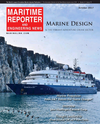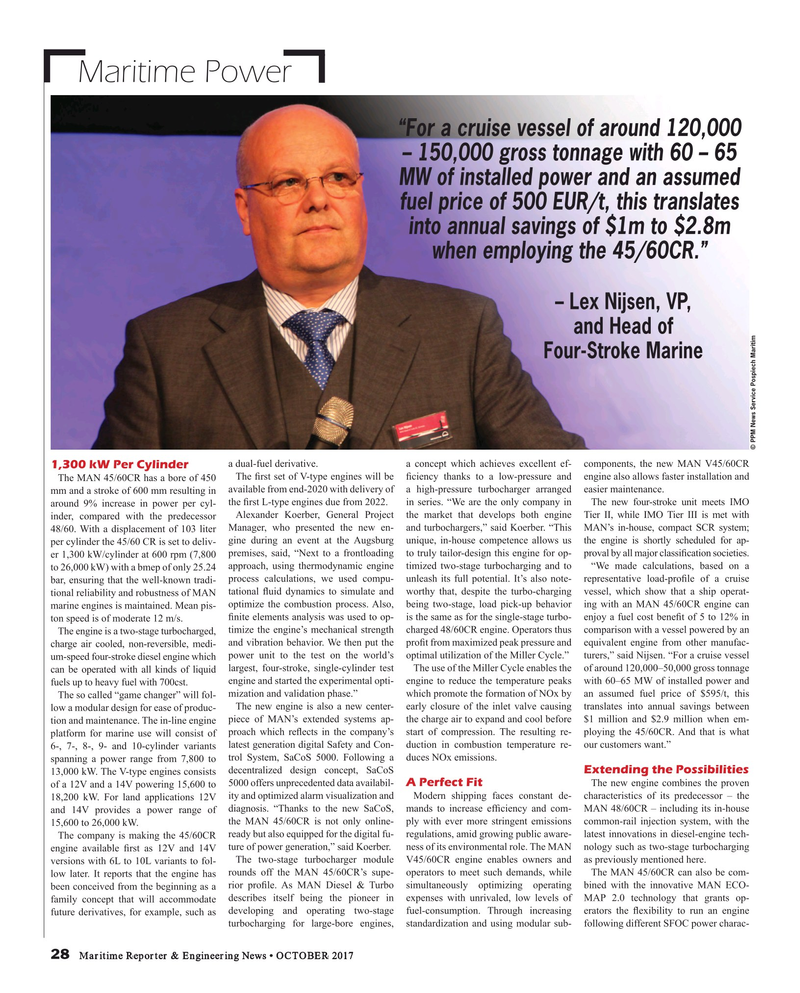
Page 28: of Maritime Reporter Magazine (October 2017)
The Marine Design Annual
Read this page in Pdf, Flash or Html5 edition of October 2017 Maritime Reporter Magazine
Maritime Power “For a cruise vessel of around 120,000 – 150,000 gross tonnage with 60 – 65
MW of installed power and an assumed fuel price of 500 EUR/t, this translates into annual savings of $1m to $2.8m when employing the 45/60CR.” – Lex Nijsen, VP, and Head of
Four-Stroke Marine © PPM News Service Pospiech Maritim a dual-fuel derivative. a concept which achieves excellent ef- components, the new MAN V45/60CR 1,300 kW Per Cylinder
The ? rst set of V-type engines will be ? ciency thanks to a low-pressure and engine also allows faster installation and
The MAN 45/60CR has a bore of 450 mm and a stroke of 600 mm resulting in available from end-2020 with delivery of a high-pressure turbocharger arranged easier maintenance.
the ? rst L-type engines due from 2022. in series. “We are the only company in The new four-stroke unit meets IMO around 9% increase in power per cyl-
Alexander Koerber, General Project the market that develops both engine Tier II, while IMO Tier III is met with inder, compared with the predecessor 48/60. With a displacement of 103 liter Manager, who presented the new en- and turbochargers,” said Koerber. “This MAN’s in-house, compact SCR system; gine during an event at the Augsburg unique, in-house competence allows us the engine is shortly scheduled for ap- per cylinder the 45/60 CR is set to deliv- er 1,300 kW/cylinder at 600 rpm (7,800 premises, said, “Next to a frontloading to truly tailor-design this engine for op- proval by all major classi? cation societies.
approach, using thermodynamic engine timized two-stage turbocharging and to “We made calculations, based on a to 26,000 kW) with a bmep of only 25.24 process calculations, we used compu- unleash its full potential. It’s also note- representative load-pro? le of a cruise bar, ensuring that the well-known tradi- tional reliability and robustness of MAN tational ? uid dynamics to simulate and worthy that, despite the turbo-charging vessel, which show that a ship operat- optimize the combustion process. Also, being two-stage, load pick-up behavior ing with an MAN 45/60CR engine can marine engines is maintained. Mean pis- ? nite elements analysis was used to op- is the same as for the single-stage turbo- enjoy a fuel cost bene? t of 5 to 12% in ton speed is of moderate 12 m/s.
The engine is a two-stage turbocharged, timize the engine’s mechanical strength charged 48/60CR engine. Operators thus comparison with a vessel powered by an and vibration behavior. We then put the pro? t from maximized peak pressure and equivalent engine from other manufac- charge air cooled, non-reversible, medi- power unit to the test on the world’s optimal utilization of the Miller Cycle.” turers,” said Nijsen. “For a cruise vessel um-speed four-stroke diesel engine which can be operated with all kinds of liquid largest, four-stroke, single-cylinder test The use of the Miller Cycle enables the of around 120,000–50,000 gross tonnage engine and started the experimental opti- engine to reduce the temperature peaks with 60–65 MW of installed power and fuels up to heavy fuel with 700cst.
mization and validation phase.” which promote the formation of NOx by an assumed fuel price of $595/t, this
The so called “game changer” will fol-
The new engine is also a new center- early closure of the inlet valve causing translates into annual savings between low a modular design for ease of produc- tion and maintenance. The in-line engine piece of MAN’s extended systems ap- the charge air to expand and cool before $1 million and $2.9 million when em- platform for marine use will consist of proach which re? ects in the company’s start of compression. The resulting re- ploying the 45/60CR. And that is what 6-, 7-, 8-, 9- and 10-cylinder variants latest generation digital Safety and Con- duction in combustion temperature re- our customers want.” spanning a power range from 7,800 to trol System, SaCoS 5000. Following a duces NOx emissions.
Extending the Possibilities 13,000 kW. The V-type engines consists decentralized design concept, SaCoS
A Perfect Fit of a 12V and a 14V powering 15,600 to 5000 offers unprecedented data availabil- The new engine combines the proven 18,200 kW. For land applications 12V ity and optimized alarm visualization and Modern shipping faces constant de- characteristics of its predecessor – the and 14V provides a power range of diagnosis. “Thanks to the new SaCoS, mands to increase ef? ciency and com- MAN 48/60CR – including its in-house the MAN 45/60CR is not only online- ply with ever more stringent emissions common-rail injection system, with the 15,600 to 26,000 kW.
The company is making the 45/60CR ready but also equipped for the digital fu- regulations, amid growing public aware- latest innovations in diesel-engine tech- engine available ? rst as 12V and 14V ture of power generation,” said Koerber. ness of its environmental role. The MAN nology such as two-stage turbocharging
The two-stage turbocharger module V45/60CR engine enables owners and as previously mentioned here. versions with 6L to 10L variants to fol- low later. It reports that the engine has rounds off the MAN 45/60CR’s supe- operators to meet such demands, while The MAN 45/60CR can also be com- been conceived from the beginning as a rior pro? le. As MAN Diesel & Turbo simultaneously optimizing operating bined with the innovative MAN ECO- family concept that will accommodate describes itself being the pioneer in expenses with unrivaled, low levels of MAP 2.0 technology that grants op- future derivatives, for example, such as developing and operating two-stage fuel-consumption. Through increasing erators the ? exibility to run an engine turbocharging for large-bore engines, standardization and using modular sub- following different SFOC power charac- 28 Maritime Reporter & Engineering News • OCTOBER 2017
MR #10 (26-33).indd 28 MR #10 (26-33).indd 28 10/4/2017 10:04:43 AM10/4/2017 10:04:43 AM

 27
27

 29
29
